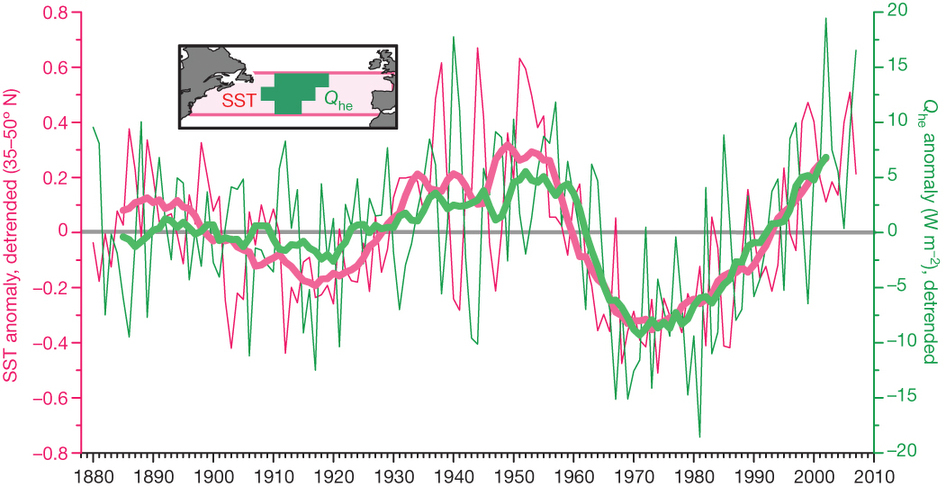Will Norway experience cold and dry winters in the next few years? Will the Northern Sea Route become more accessible? Climate prediction models, principally like those for weather forecasting, are under development to answer such questions of large societal importance, or, more precisely, to provide a confident range and probability of possible outcomes.
Dynamical seasonal-to-decadal climate prediction is an emerging research field. Recent progress is documented in the IPCC WG1 Fifth Assessment Report (AR5); it is in general still unknown to what extent climate is predictable on interannual to decadal timescales – both from a theoretical and a practical perspective. In PRACTICE, the Bjerknes Centre has invested to make climate prediction a strategic priority. The Norwegian Climate Prediction Model (NorCPM) has accordingly been realized and tested in an idealized framework (Counillon et al., 2014; see also page 13).
With a first prototype of NorCPM in place, the Bjerknes Centre is now engaging more actively in the international research effort to resolve this scientific question of foremost societal importance. PRACTICE has in parallel kept a strong focus on assessing potential predictability from confronting possible mechanisms with the observational record. Key cause-and-effect relations have been indicated, e.g., for North Atlantic atmosphere–ocean heat exchange (Gulev et al., 2013, see figure and page 14), and for the strength andstructure of the Gulf Stream’s extension toward and into the Arctic (Eldevik and Nilsen, 2013; Lien et al., 2013, see also pages 12 and 13). Such identified relations will increasingly be converted into corresponding frameworks for model evaluation (Sandø et al., 2014).
The PRACTICE team dedicated much of 2013 to consolidating and further increasing the resources for climate prediction as a core activity at the Bjerknes Centre. Four projects were funded as a result, with EPOCASA (RCN) and PREFACE (EU) for further testing and development of the NorCPM-system in a realistic framework, and GREENICE (NordForsk) and NORTH (NFR) more dedicated to mechanisms and associated frameworks for model evaluation. Through the national and international consortiums thus established, links are now formalized with the main EU projects on climate prediction (NACLIM and SPECS).
An emerging priority for PRACTICE is to develop – in parallel with the ongoing research and model developments on predictability – tailored prediction output fit for decision makers, resource management, businesses, and the general public. PRACTICE has thus actively engaged in a recently submitted proposal for a “Centre for Research-based Innovation” in Bergen on the topic, and in a national research plan commissioned by the Ministry of Education and Research for a holistic assessment of the ecosystem of the Barents Sea (Eldevik et al., 2014). The aspect of predictability and regional impacts of climate change will be advocated as a priority for the next round of SKD strategic projects.

_________
Counillon, F., Bethke, I., Keenlyside, N., Bentsen, M., Bertino, L. and Zheng , F. (2014 ). Seasonal- to -decadal predictions with the Ensemble Kalman Filter and the Norwegian Earth System Model: a twin experiment. Tellus A, in press.
Eldevik, T. and Nilsen, J. E. Ø . (2013): The Arctic – Atlantic thermohaline circulation. J. Climate, 26, 8698–8705.
Eldevik, T., Reigstad, M. , Falck, E., Gerland, S., Jentoft, S., Johnsen, G., Lindstrøm, U., Rasmussen, T. L., Røed, L. P. and Wassmann, P. F. (2014): Arven etter Nansen. Forsknings- plan for det sentrale og nordlige Barentsha vet. UiT Norges arktiske universitet, 48pp. (nansenlegacy.org)
Gulev, S. K., Latif, M., Keenlyside , N., Park, W. and Koltermann, K. P. (2013): North Atlantic Ocean control on surface heat flux at multidecadal timescales. Nature, 499, 464–467-
Lien, V. S., Vikebø , F. B. and Skagseth , Ø. (2013): One mechanism contributing to co-variability of the At lantic inflow branches to the Arctic. Nat. Commun., 4 , doi: 10.1038/ncomms2505.
Sandø, A. B., Gao, Y. and Langehaug , H. R. (2014 ): Relation between ocean heat transports, sea ice processe s and Arctic sea ice variability in NorESM1-M simulations. J. Geophys. Res. Oceans, 119, 2095-2108, doi:10.1002/2013JC009435.
